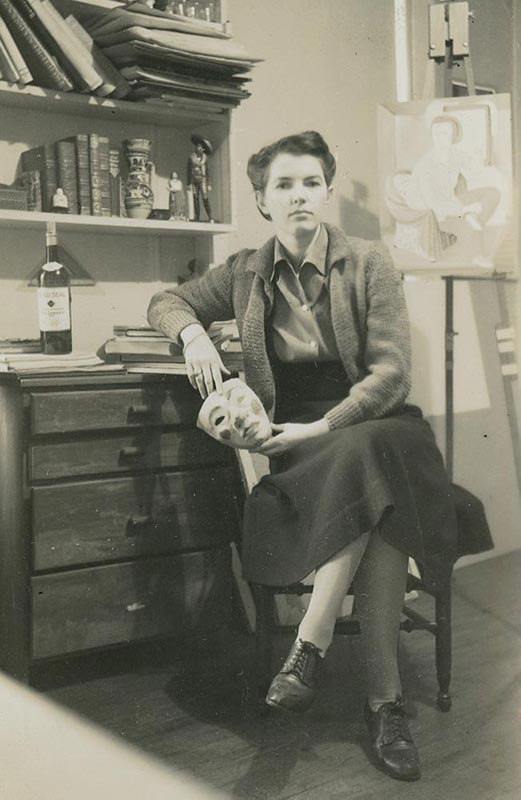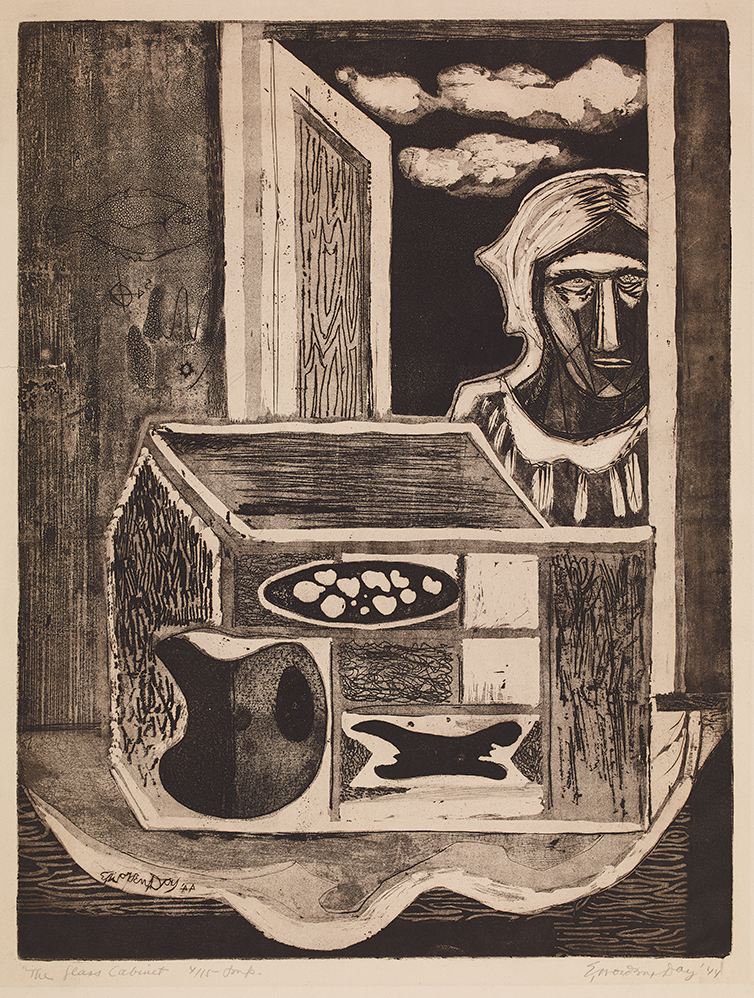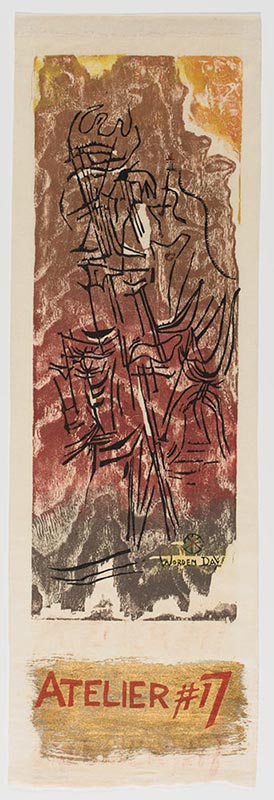21. Worden Day
| Life Dates | 1912-1986 |
| Place of Birth | Columbus, OH, USA |
| Place of Death | Montclair, NJ, USA |
| Birth Name | Esther A. Day |
Esther A. Day was born in 1912 in Columbus, Ohio, the youngest child and only daughter of Daniel and Katherine Day, respectively a Methodist minister and the daughter of the lighthouse keeper on Great Captain Island in Greenwich, Connecticut.1 Day described her parents as “hippies,” owing to their relatively eccentric dress and liberal ideologies, which contributed to her father’s dismissal from the Methodist Conference before her birth. Day’s earliest years were spent on a farm outside Hopewell, Virginia, which sits at the fork between the James and Appomattox Rivers. The city’s population boomed after the DuPont Company opened a dynamite factory there, and Day’s father resumed preaching in 1915 on a “freelance” basis to the souls of rural Virginia.2 As a child, Day witnessed the frenetic performances of evangelical preachers like Billy Sunday and Aimee McPherson when traveling “on the circuit” with her family. Drawing with crayons in between church pews as a child—intended to keep her quiet during services—fostered an early interest in art.3 The Days moved frequently within Virginia, and they settled by 1920 in Alexandria. Her engagement in the arts grew through proximity to Washington D.C.’s museums, particularly the Corcoran Gallery of Art, Phillips Collection, Freer Gallery of Art, and Smithsonian Institution.4
Day was the valedictorian of her high school class and earned a scholarship to Randolph-Macon Woman’s College, from which she graduated in 1934. Upon graduation, the Pennsylvania Academy of the Fine Arts offered Day a scholarship but she knew that New York City had a more vibrant arts community. Living in New York for six years before departing for various traveling fellowships, Day worked a number of jobs—waitress, medical illustrator, packager of spices, contract lithographer, among others—while devoting herself to art studies at several local institutions.5 Day was perpetually enrolled at the Art Students League, where she took in classes with a smattering of teachers, including life classes with Leon Kroll, William von Schlegell, Yasuo Kuniyoshi, Jean Charlot, and Vaclav Vytlacil and printmaking classes with Harry Sternberg and Will Barnet.6 In addition to the League, she sought out instruction at two other schools. In her first year in New York, she enrolled in classes at the independent studio of the Latvian-born artist Maurice Sterne and recently emigrated German expressionist George Grosz. After one year with Sterne-Grosz, she switched to the Florence Cane School of Art, remaining there from 1935 to 1937.7 Day’s teachers at the Cane School were Jean Charlot and Emilio Amero, both in their own ways greatly influenced by Mexican history and the country’s homegrown modernism. From them, she learned a wide-ranging set of skills, which included a host of printmaking techniques. Almost immediately, she put her lessons into practical use as the supervisor of a workshop run by the Works Progress Administration that printed remedial reading books for New York City’s public schools using a color offset lithography press.
After much searching, Day’s world came together in the fall of 1938 when she found Vaclav Vytlacil’s class at the League. She not only discovered an inspiring teacher, but she also entered the vibrant community of young artists who congregated around “Vyt,” as they called him, and his mentor Hans Hofmann, who was at that point teaching downtown on Eighth Street. Since arriving in New York in 1934, Day had been searching for a network of “serious art students” and been disappointed, particularly with the caliber of students at Sterne-Grosz’s school where most were “wealthy women with a sprinkling of doctors and retired businessmen.”8 Among her closest colleagues from Vytlacil’s class were the painter Bessie Boris (1917-1993), Leo Garel, and Don Duncan. As Day said, they became “inseparable friends,” socializing at each other’s studios, imbibing and cooking dinner together, discussing poetry and one another’s paintings, shuttling back and forth between the Vytlacil’s classroom at the League and Hofmann’s studio on Eighth Street, and going to various summer art colonies.
All of these activities culminated in several early professional achievements for Day. She had three major exhibitions in 1940: a “duo” show with Mark Baum (1903-1997) at Perls Gallery in New York City and solo shows at her alma mater and at the Virginia Museum of Fine Arts.9 Her style at this point was decidedly realist and regionalist with a twinge of surrealism. Day admired the brooding and enigmatic canvases of Giorgio de Chirico, and she created her own surrealistic situations inspired by the world she was most familiar—rural America. Winning two traveling fellowships, the first from the Virginia Museum of Fine Arts and the second from the Julius Rosenwald Fund, she left New York City just as Hayter was reestablishing Atelier 17 in America. Hearing about the printmaking workshop during her second year as a Rosenwald fellow, she returned to New York in 1942 to attend Hayter’s course. Having some experience already in printmaking, she was ready to dive into Hayter’s teachings and use engraving as way to discover more about herself personally and as an artist. The Glass Cabinet is perhaps a self-portrait of Day peering in through a window at a dollhouse filled with unusual objects such a s a pitcher and plate. On the wall, there are linear drawings of a fish, a compass, and a four-fingered hand—strangely foreshadowing Day’s fascination with ancient petroglyphs she would see in the American west only a few years later.
She found herself drawn to the sculptural quality of engraving and, throughout the next decade, increasingly gravitated toward carving woodcuts and eventually creating three dimensional wooden sculptures. Day even taught a woodcut course at Atelier 17 upon her return to Atelier 17 after a stint as assistant professor at the University of Wyoming at Laramie.10 It is very likely that Day’s woodcut Atelier 17 commemorates this class, perhaps serving as a promotional poster. Atelier 17 also satisfied Day’s lifelong desire to be part of an energetic and engaged network of artists, and she formed cross-generational relationships with many members of the workshop whose prints she generously distributed across the country during various visiting fellowships and teaching positions in Kentucky, Missouri, Wyoming, and elsewhere. Day returned to Atelier 17 on several occasions between these “out-of-town” gigs, revealing the value she placed on the studio’s aesthetic experimentation and sense of community.
- Biographical entry revised November 2020
Archives
Worden Day Papers, 1940–1982, Archives of American Art, Smithsonian Institution, Washington, D.C.
Selected Bibliography
Bier, Justus. “Art: Worden Day’s Gravures Show Ingenious New Methods.” The Courier-Journal. October 20, 1946.
———. “Art: Worden Day’s Work Is Inventive and Poetic.” The Courier-Journal. December 15, 1946.
Colt, Jr., Thomas C. Esther Worden Day. Virginia Artist Series, No. 16. Richmond, VA: Virginia Museum of Fine Arts, 1940.
Day, Worden. “Experiments in Woodcut.” Artists Proof 1, no. 2 (1961): 26–27.
———. “Why Painters Turn Sculptors.” Art Voices 4, no. 1 (Winter 1965): 52–57.
Gilbert, Creighton. The Prints of Worden Day. Louisville, KY: University Library, University of Louisville, 1953.
Johnson, Una. Worden Day 40 Year Retrospective, 1946-1986: Drawings, Paintings, Prints and Sculpture. Trenton, NJ: New Jersey State Museum, 1986.
Johnson, Una E. Worden Day: Paintings, Collages, Drawings, and Prints. Montclair, NJ: Montclair Art Museum, 1959.
“Woodcut Course at Atelier 17.” Arts Digest 29 (November 15, 1954): 15.
Weyl, Christina. “Missing Archives: Worden Day and Women Modernists.” Archives of American Art Journal 58, no. 2 (Fall 2019): 24-45.
Notes
- Day consistently gave 1916 as her birth year, but government records instead indicate she was born in 1912. A “Certification of Birth” issued by Ohio’s Office of Vital Statistics and obtained by the author on December 6, 2017 confirm her birth on June 15, 1912. This birth year is echoed in the 1920 and 1940 census data and the Social Security Death Index. Like many women of her generation, Day probably walked back her birth year to make herself appear younger and more accomplished and to combat ageism in the art world. ↩
- For more about her parents, see Day, “The Spiritual Journey of Worden Day,” 1, Worden Day Papers, Archives of American Art, Smithsonian Institution [henceforth WDP]; “Wealthy, Retired Minister Hears Pulpit Calling Him,” Harrisburg Telegraph, July 10, 1915, 6. ↩
- Worden Day, “Autobiographical Journey,” 1, WDP. “Autobiographical Journey” was later reproduced in Day’s memorial exhibition: Una Johnson, Worden Day 40 Year Retrospective, 1946-1986: Drawings, Paintings, Prints and Sculpture (Trenton, NJ: New Jersey State Museum, 1986), unpaginated. I will reference the paginated copy in WDP. ↩
- Day, “Autobiographical Journey,” 1; “Events that have had a Striking impact on my life,” #3, WDP (DuHamel). ↩
- Thomas C. Colt, Jr., Esther Worden Day, Virginia Artist Series, No. 16 (Richmond, VA: Virginia Museum of Fine Arts, 1940). ↩
- Student registration card, Art Students League of New York. ↩
- Florence Cane (1882-1952) was a progressive educator and art therapist who was a follower of psychoanalysis and believed in the power of art making to uncover aspects of the human psyche and to bring a sense of completeness to an individual’s identity. Strains of her ideology appeared in Day’s 1965 article “Why Painters Turn Sculptors,” which explores how sculpture enabled many artists to tap into their “true dimension,” a synonym for one’s identity. ↩
- Day, “Autobiographical Journey as an Artist.” ↩
- Brochures for two of these shows are in WDP, reel 981:286-9. ↩
- See notice of the class in “Woodcut Course at Atelier 17,” Arts Digest 29 (November 15, 1954): 15. In addition to the impression from the Philadelphia Museum illustrated here, another impressions can be found at the New York Public Library (call no. MEYN+). ↩


